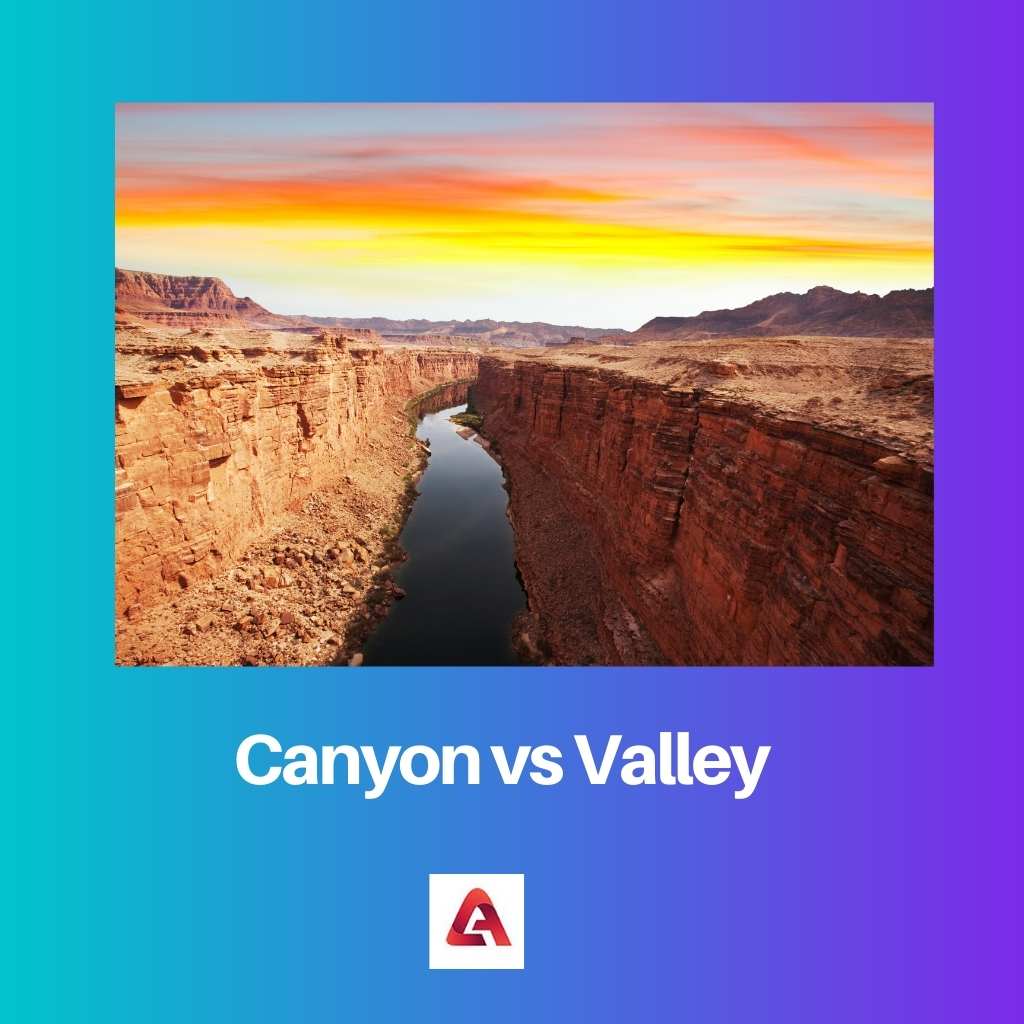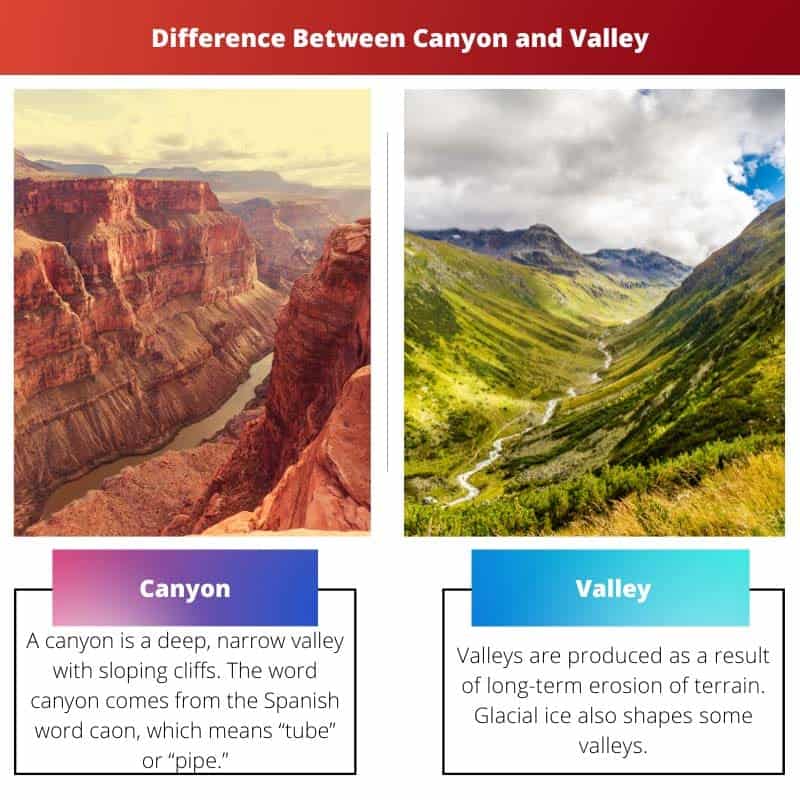If a river flows through a mountain, it eventually carves out a deep channel through which it can flow. A canyon is defined as a deep depression between two cliffs on a mountain.
A deep valley carved out of a mountain by a river is another name for it.
In the case of both a valley and a canyon, a deep depression in a mountain is formed that goes down to the bottom of the mountain, forming a U or V shape with steep walls of the mountain on either side of the valley and canyon.
Due to their similarities, it is difficult to distinguish between two different landforms.
Key Takeaways
- Canyons are deep, narrow, and steep-walled landforms, while valleys are elongated lowlands between hills or mountains.
- Canyons form through erosion by rivers, whereas valleys form through various geological processes, such as erosion, glaciation, or tectonic activity.
- Canyons are found in arid regions, while valleys can be found in diverse environments and may have fertile soil for agriculture.
Canyon vs Valley
A canyon is a deep, narrow valley with steep sides, carved out by a river over a long period of time. A valley is a low land area between hills or mountains, with a river or streams running through it. Canyons are considered more dramatic and visually striking than valleys.

A canyon is a deep, narrow valley with sloping cliffs. The word canyon comes from the Spanish word caon, which means “tube” or “pipe.”
Weathering, river movement, and tectonic action can all cause canyons to develop. They are available in a range of sizes, from huge trenches to small slits. They have extremely steep slopes and are rather deep.
Valleys are produced as a result of long-term erosion of terrain. Glacial ice also shapes some valleys. Valleys in deserted areas are very dry, or they may contain a river, but this is uncommon.
Then there’s the rift valley, which is formed by the movement of the earth. Valleys are given many names based on their qualities, such as Steelhead Valley, Dry Valley, Longitudinal Valley, and so on.
Comparison Table
| Parameters of Comparison | Canyon | Valley |
|---|---|---|
| Definition | Deep, narrow valley with steep sides | The low area of land between hills and mountains |
| Depth | Deeper | Less deep |
| Steep | Steeper | Less steep |
| Examples | Grand Canyon, Yarlung Zangbo Grand Canyon, Kings Canyon, Fish River Canyon, etc. | Kashmir valley, Jiuzhaigou valley, Great Appalachian Valley, Yosemite Valley, etc. |
| Size | Smaller | Larger |
What is Canyon?
Canyons are formed mostly as a result of erosion. A canyon or valley is formed when the passage of water in a river erodes soil and rocks over thousands of years.
Some of the world’s biggest canyons were formed in arid areas by rapid streams fed by melting snow or rain from colder and wetter areas.
The walls remain rugged and steep because there is little surface water or rain to wear them down.
Deep underwater, canyons can also be discovered. These are known as undersea canyons. They are found at continents’ borders and on some ocean islands.
The Grand Bahama Canyon, located in the Atlantic Ocean in the Bahamas, is the deepest submarine canyon.
A canyon, also known as a gorge, is a deep gorge formed by weathering of a river. A river bed will progressively achieve a baseline height that corresponds to the elevation of the body of water into which the river drains.
The majority of canyons were produced by long-term erosion from a plateau or tableland level. Cliffs arise when tougher rock layers resistant to weathering of rocks remain exposed on valley walls.
As a result of progressive geological uplift, big rivers can sometimes run through canyons. Because they are unable to change their course readily, these rivers are referred to as entrenched rivers.
Canyons are frequently formed in areas of limestone rock. Cave systems arise in limestone because it is soluble to some extent. A canyon is formed when a cave system collapses.

What is Valley?
Valley floor refers to the area of the valley that is flat between its sides. River sediments are responsible for its formation.
Plain, U-shaped, and V-shaped valleys can occur depending on the rock type, climate, and geography. Valleys can be shaped in a variety of ways, including hanging, trough-shaped, and box-shaped.
Valleys are helpful because they are connected to water, which is a fresh source of water that can be used for irrigation and the agricultural process.
There is virtually little possibility of flooding in the valley. A valley is a depression or hollow. It is much larger than the basin but much narrower.
It is a low-lying section of land that has been scraped and swept away by gravity, water, and ice. It is common in the shape of a U or V. It also has a “head,” “sides,” and a “floor.”
Rivers and streams can create valleys with steep-walled sides and a narrow floor, commonly in the shape of a V. The gradient of the river determines the steepness of the valley sides and the width of the valley floor.
Because of their proximity to rivers and the lush soil in the valleys, many civilizations around the world began in valleys. The Kli Gandaki River valley in Nepal is the world’s deepest subaerial valley.
Valleys in arid areas may be completely dry or only sometimes carry a stream. Dry valleys may form in limestone bedrock locations as a result of subsurface drainage rather than surface drainage.
Rift valleys are formed mostly by earth movements rather than erosion.

Main Differences Between Canyon and Valley
- Canyons are deep and narrow valleys, whereas a valley is land between mountain ranges.
- A canyon is deeper in comparison to a valley.
- A canyon is steeper than a valley.
- Examples of canyons can include the Grand Canyon, Fish River Canyon, etc. Examples of valleys can be Kashmir valley, Yosemite Valley, etc.
- A canyon is smaller in size than a valley which tends to be larger on average.

References
- https://www.tandfonline.com/doi/abs/10.3166/ga.17.241-251
- https://pubs.geoscienceworld.org/ssa/aapgbull/article/101/7/1073/520547
